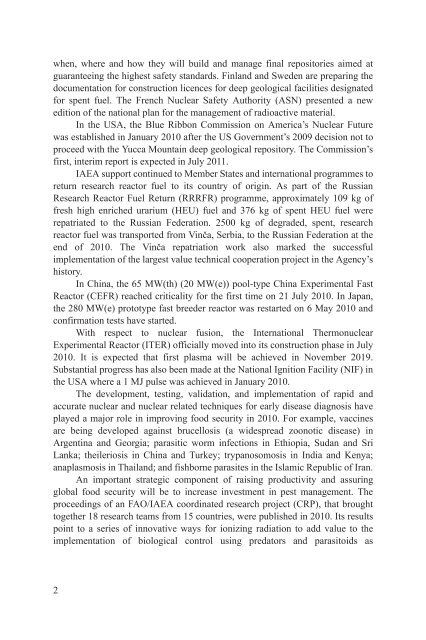Nuclear Technology Review 2011 - IAEA
Nuclear Technology Review 2011 - IAEA
Nuclear Technology Review 2011 - IAEA
You also want an ePaper? Increase the reach of your titles
YUMPU automatically turns print PDFs into web optimized ePapers that Google loves.
when, where and how they will build and manage final repositories aimed at<br />
guaranteeing the highest safety standards. Finland and Sweden are preparing the<br />
documentation for construction licences for deep geological facilities designated<br />
for spent fuel. The French <strong>Nuclear</strong> Safety Authority (ASN) presented a new<br />
edition of the national plan for the management of radioactive material.<br />
In the USA, the Blue Ribbon Commission on America’s <strong>Nuclear</strong> Future<br />
was established in January 2010 after the US Government’s 2009 decision not to<br />
proceed with the Yucca Mountain deep geological repository. The Commission’s<br />
first, interim report is expected in July <strong>2011</strong>.<br />
<strong>IAEA</strong> support continued to Member States and international programmes to<br />
return research reactor fuel to its country of origin. As part of the Russian<br />
Research Reactor Fuel Return (RRRFR) programme, approximately 109 kg of<br />
fresh high enriched urarium (HEU) fuel and 376 kg of spent HEU fuel were<br />
repatriated to the Russian Federation. 2500 kg of degraded, spent, research<br />
reactor fuel was transported from Vinča, Serbia, to the Russian Federation at the<br />
end of 2010. The Vinča repatriation work also marked the successful<br />
implementation of the largest value technical cooperation project in the Agency’s<br />
history.<br />
In China, the 65 MW(th) (20 MW(e)) pool-type China Experimental Fast<br />
Reactor (CEFR) reached criticality for the first time on 21 July 2010. In Japan,<br />
the 280 MW(e) prototype fast breeder reactor was restarted on 6 May 2010 and<br />
confirmation tests have started.<br />
With respect to nuclear fusion, the International Thermonuclear<br />
Experimental Reactor (ITER) officially moved into its construction phase in July<br />
2010. It is expected that first plasma will be achieved in November 2019.<br />
Substantial progress has also been made at the National Ignition Facility (NIF) in<br />
the USA where a 1 MJ pulse was achieved in January 2010.<br />
The development, testing, validation, and implementation of rapid and<br />
accurate nuclear and nuclear related techniques for early disease diagnosis have<br />
played a major role in improving food security in 2010. For example, vaccines<br />
are being developed against brucellosis (a widespread zoonotic disease) in<br />
Argentina and Georgia; parasitic worm infections in Ethiopia, Sudan and Sri<br />
Lanka; theileriosis in China and Turkey; trypanosomosis in India and Kenya;<br />
anaplasmosis in Thailand; and fishborne parasites in the Islamic Republic of Iran.<br />
An important strategic component of raising productivity and assuring<br />
global food security will be to increase investment in pest management. The<br />
proceedings of an FAO/<strong>IAEA</strong> coordinated research project (CRP), that brought<br />
together 18 research teams from 15 countries, were published in 2010. Its results<br />
point to a series of innovative ways for ionizing radiation to add value to the<br />
implementation of biological control using predators and parasitoids as<br />
2

















